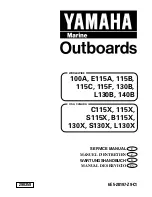Serial Management Controllers (SMCs)
MPC885 PowerQUICC Family Reference Manual, Rev. 2
29-30
Freescale Semiconductor
4. Write RBASE and TBASE in the SMC parameter RAM to point to the RxBD and TxBD in the
dual-port RAM. Assuming one RxBD at the beginning of the dual-port RAM followed by one
TxBD, write RBASE with 0x0000 and TBASE with 0x0008.
5. Program CPCR to execute the
INIT
RX
AND
TX
PARAMETERS
command. Write 0x0091 to CPCR.
6. Write 0x0001 to the SDCR to initialize the SDCR.
7. Write RFCR and TFCR with 0x10 for normal operation.
8. Write MRBLR with the maximum bytes per receive buffer. Assuming 16 bytes, MRBLR =
0x0010.
9. Initialize the RxBD assuming the buffer is at 0x0000_1000 in main memory. Write 0xB000 to
RxBD[Status and Control], 0x0000 to RxBD[Data Length] (optional), and 0x0000_1000 to
RxBD[Buffer Pointer].
10. Initialize the TxBD assuming the Tx buffer is at 0x0000_2000 in main memory and contains five
8-bit characters. Write 0xB000 to TxBD[Status and Control], 0x0005 to TxBD[Data Length], and
0x0000_2000 to TxBD[Buffer Pointer].
11. Write 0xFF to SMCE to clear any previous events.
12. Write 0x13 to SMCM to enable all possible SMC interrupts.
13. Write 0x0000_0010 to the CIMR to allow SMC1 to generate a system interrupt. The CICR should
also be initialized.
14. Write 0x3830 to the SMCMR to configure 8-bit characters, unreversed data, and normal operation
(not loopback). The transmitter and receiver are not enabled yet.
15. Write 0x3833 to the SMCMR to enable the SMC transmitter and receiver. This additional write
ensures that TEN and REN are enabled last.
After 5 bytes are sent, the TxBD is closed; after 16 bytes are received the receive buffer is closed. Any data
received after 16 bytes causes a busy (out-of-buffers) condition since only one RxBD is prepared.
29.4.13 SMC Transparent TSA Programming Example
The following is an example initialization sequence for the SMC1 transparent channel over the TSA. It is
assumed that the TSA and the TDM pins have been set up to route time-slot data to the SMC transmitter
and receiver.
Chapter 20, “Serial Interface,”
has examples for configuring the TSA which provides
transmit and receive clocks and synchronization signals internally.
1. Write RBASE and TBASE in the SMC parameter RAM to point to the RxBD and TxBD in the
dual-port RAM. Assuming one RxBD at the beginning of the dual-port RAM followed by one
TxBD, write RBASE with 0x0000 and TBASE with 0x0008.
2. Program CPCR to execute the
INIT
TX
AND
RX
PARAMETERS
command. Write 0x0091 to CPCR.
3. Initialize the SDCR to 0x0001.
4. Write RFCR and TFCR with 0x10 for normal operation.
5. Write MRBLR with the maximum number of bytes per receive buffer. Assume 16 bytes, so
MRBLR = 0x0010.
Summary of Contents for PowerQUICC MPC870
Page 98: ...MPC885 PowerQUICC Family Reference Manual Rev 2 I 4 Freescale Semiconductor ...
Page 118: ...MPC885 Overview MPC885 PowerQUICC Family Reference Manual Rev 2 1 20 Freescale Semiconductor ...
Page 158: ...The MPC8xx Core MPC885 PowerQUICC Family Reference Manual Rev 2 3 18 Freescale Semiconductor ...
Page 288: ...MPC885 PowerQUICC Family Reference Manual Rev 2 III 4 Freescale Semiconductor ...
Page 554: ...MPC885 PowerQUICC Family Reference Manual Rev 2 V 6 Freescale Semiconductor ...
Page 1090: ...UTOPIA Interface MPC885 PowerQUICC Family Reference Manual Rev 2 43 8 Freescale Semiconductor ...
Page 1312: ...Byte Ordering MPC885 PowerQUICC Family Reference Manual Rev 2 A 8 Freescale Semiconductor ...
Page 1336: ...MPC885 PowerQUICC Family Reference Manual Rev 2 D 16 Freescale Semiconductor ...
Page 1358: ...MPC885 PowerQUICC Family Reference Manual Rev 2 D 38 Freescale Semiconductor ...
Page 1370: ...MPC880 MPC885 PowerQUICC Family Reference Manual Rev 2 E 4 Freescale Semiconductor ...
Page 1386: ...Revision History MPC885 PowerQUICC Family Reference Manual Rev 2 I 2 Freescale Semiconductor ...

















